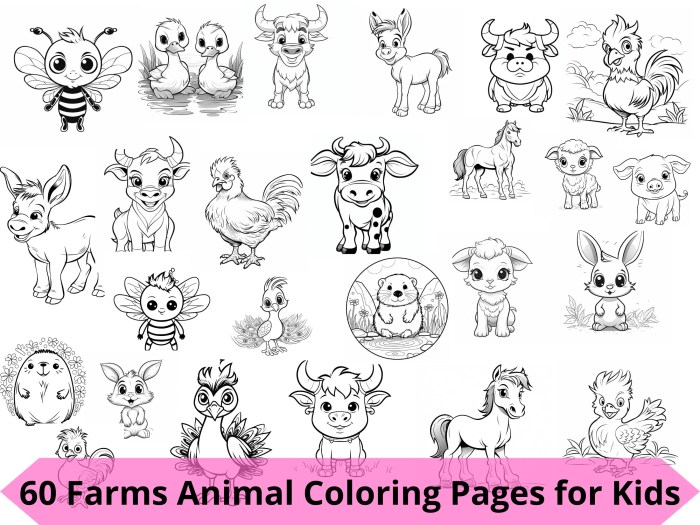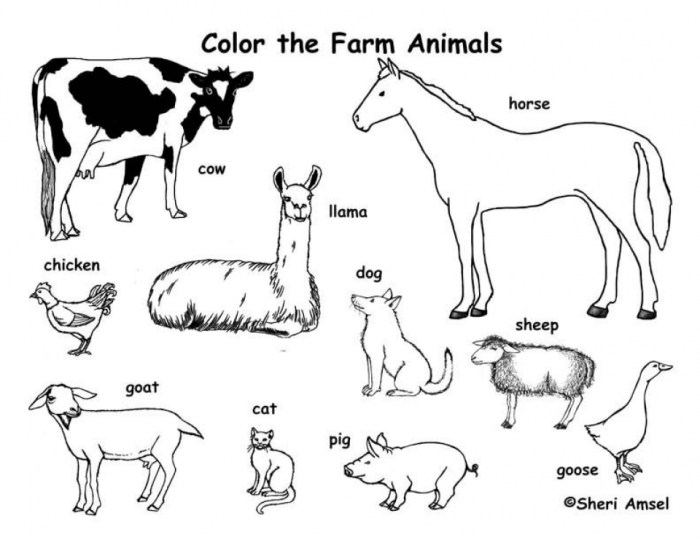Educational Value of Farm Animal Coloring Pages

Farm animal coloring pictures for 6th graders – Adoi, baa… coloring pages aren’t just for little ones! For 6th graders, these farm animal coloring activities offer a surprisingly rich educational experience, blending creativity with learning in a fun and engaging way. They provide a valuable opportunity to reinforce classroom learning and develop crucial skills.
Cognitive Benefits of Coloring for Sixth Graders
Coloring, even at the 6th-grade level, provides significant cognitive benefits. The act of focusing on staying within the lines, choosing colors, and creating a finished picture improves fine motor skills and hand-eye coordination. It also encourages concentration and mindfulness, helping students to relax and de-stress after a demanding school day. The creative process itself stimulates imagination and self-expression, allowing students to explore their artistic abilities and develop a sense of accomplishment.
Furthermore, the act of completing a coloring page fosters a sense of patience and perseverance.
Enhancing Agricultural Vocabulary
Farm animal coloring pages offer a fantastic opportunity to expand vocabulary related to agriculture. By providing labels or incorporating them into accompanying activities, students can learn and reinforce terms like “Holstein,” “Angus,” “barrow,” “ewe,” “chick,” “goat,” “pasture,” “barn,” “silo,” and many more. The visual association with the animal or object enhances memorization and comprehension. This method aids in building a solid foundation of agricultural terminology, laying the groundwork for future learning in science and other related subjects.
The use of flashcards or interactive quizzes alongside the coloring activity can further solidify vocabulary acquisition.
Supporting Learning about Animal Habitats and Diets
These coloring pages can go beyond simple pictures. By including details about the animals’ natural habitats and dietary needs, students gain a deeper understanding of their life cycles and ecological roles. For example, a coloring page featuring a cow might depict a pasture, highlighting the importance of grazing. Similarly, a pig coloring page could show a mud wallow, explaining its role in thermoregulation.
By associating visual representations with factual information, these coloring pages transform a simple activity into a valuable learning tool. Including small text boxes or interactive elements can further enrich this learning experience, fostering a more holistic understanding of farm animal life.
Complexity of Coloring Pages for Different Sixth-Grade Age Ranges
The complexity of coloring pages should be tailored to the individual student’s developmental stage within the 6th-grade range. Here’s a table illustrating this:
| Age Range | Animal Complexity | Detail Level | Color Palette Suggestions |
|---|---|---|---|
| 11-11.5 years | Simple farm animals (e.g., chicken, pig) | Low to medium detail (basic shapes, few lines) | Basic primary and secondary colors |
| 11.5-12 years | More detailed farm animals (e.g., cow with markings, sheep with wool texture) | Medium detail (more intricate lines, shading suggestions) | Wider range of colors, including earth tones |
| 12-12.5 years | Complex farm animals (e.g., horse with detailed musculature, goat with distinct facial features) | High detail (fine lines, complex patterns, shading) | Varied color palette, including subtle shades and tints |
| 12.5-13 years | Farm animals in scenes (e.g., cows in a pasture, pigs in a pen) | High detail, multiple animals and background elements | Realistic color palettes, blending techniques encouraged |
Exploring Different Farm Animals: Farm Animal Coloring Pictures For 6th Graders

A colorful world awaits us as we delve into the fascinating lives of farm animals! From the familiar cows and chickens to some lesser-known creatures, each animal plays a vital role in the farm ecosystem. Understanding their unique characteristics, roles, and interesting facts enhances our appreciation for these hardworking creatures and makes coloring them even more engaging. This exploration will provide a richer understanding of the diversity found within farm animal life.
Five Less Common Farm Animals and Their Unique Features, Farm animal coloring pictures for 6th graders
Let’s discover some farm animals that may not be as familiar as cows or pigs. These animals offer unique coloring opportunities, showcasing diverse textures, patterns, and colors in their coats and feathers. Their unique features also provide engaging learning opportunities.
- Llama: These South American camelids are known for their long, soft fleece, which can range from white to brown, black, and even gray. Their long necks and inquisitive faces make them delightful subjects for coloring.
- Alpaca: Close relatives of llamas, alpacas also possess luxurious fleece, but their faces are shorter and sweeter. Their fleece comes in a wider variety of colors, including some vibrant hues.
- Angora Goat: These goats are prized for their incredibly long, silky fleece, used to make mohair. Their fluffy coats offer a wonderful texture to depict in a coloring page.
- Muscovy Duck: Unlike domestic ducks, Muscovy ducks have red facial wattles and caruncles, adding unique details to their coloring page depiction. Their plumage can range from black and white to brown and speckled.
- Guinea Fowl: These birds are known for their speckled plumage and distinctive calls. Their feathers are a mix of brown, gray, and white, creating a mottled effect that’s visually interesting.
Comparing and Contrasting Three Cow Breeds
Cows, a staple of many farms, exhibit significant diversity in breeds, each with unique physical characteristics. Understanding these differences enriches our appreciation for their variety and the specific roles they play.
- Holstein Friesian: This breed is easily recognizable by its distinctive black and white markings. They are known for their high milk production.
- Angus: Angus cattle are known for their completely black coat, making them a striking contrast to the Holsteins. They are a beef breed, prized for their marbling and tenderness.
- Jersey: Jersey cows are smaller than Holsteins and are known for their rich, golden-brown coat. They are also a dairy breed, but their milk is higher in butterfat than that of Holsteins.
Categorizing Farm Animals by Role
Farm animals contribute to various aspects of farm production. Categorizing them by their primary role helps illustrate their importance within the farm ecosystem.
- Dairy: Cows (Holstein, Jersey, Guernsey), Goats
- Meat: Pigs, Cattle (Angus, Hereford), Sheep, Chickens (broilers)
- Egg Production: Chickens (layers), Ducks, Turkeys
- Fiber Production: Sheep, Alpacas, Llamas, Angora Goats
- Draft/Work: Horses, Donkeys, Oxen
Interesting Facts about Five Less Common Farm Animals
These intriguing facts add depth to our understanding of these less familiar farm animals, making them more engaging subjects for study and coloring.
- Llama: Llamas are known for their gentle nature and are often used as guard animals for sheep.
- Alpaca: Alpaca fleece is exceptionally soft and hypoallergenic.
- Angora Goat: Angora goats can produce up to 5 pounds of mohair per shearing.
- Muscovy Duck: Muscovy ducks are known for their quiet nature compared to other ducks.
- Guinea Fowl: Guinea fowl are excellent insect control on farms.
Farm animal coloring pictures offer a relaxing and engaging activity for 6th graders, fostering creativity and fine motor skills. This is especially true considering that, as the website everyone loves coloring animals colored pages demonstrates, the appeal of animal coloring pages spans a wide age range. Therefore, providing farm animal themed coloring sheets can be a valuable educational tool, offering a fun and beneficial learning experience for students of this age group.
